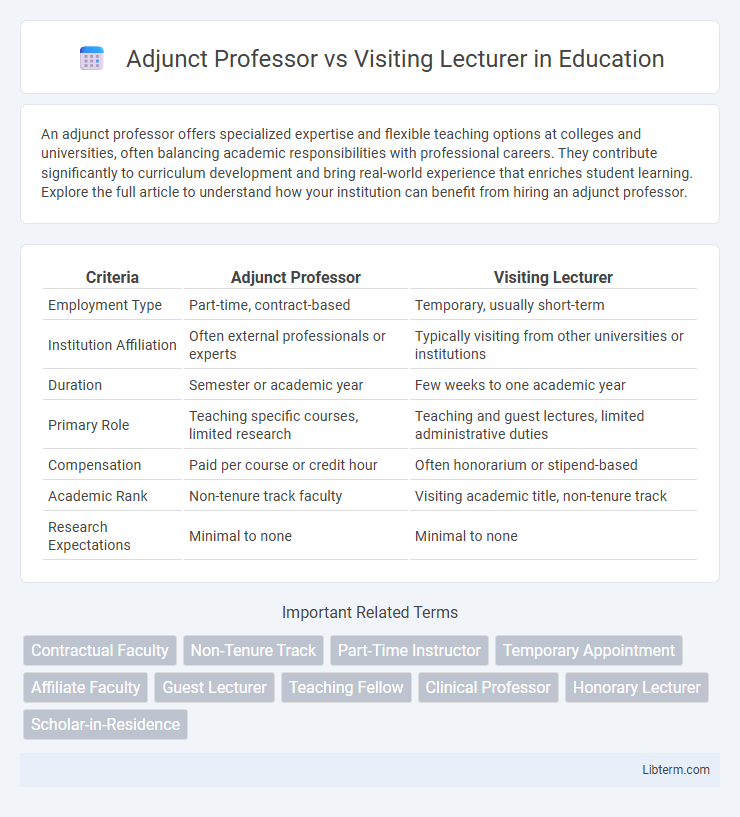An adjunct professor offers specialized expertise and flexible teaching options at colleges and universities, often balancing academic responsibilities with professional careers. They contribute significantly to curriculum development and bring real-world experience that enriches student learning. Explore the full article to understand how your institution can benefit from hiring an adjunct professor.
Table of Comparison
| Criteria | Adjunct Professor | Visiting Lecturer |
|---|---|---|
| Employment Type | Part-time, contract-based | Temporary, usually short-term |
| Institution Affiliation | Often external professionals or experts | Typically visiting from other universities or institutions |
| Duration | Semester or academic year | Few weeks to one academic year |
| Primary Role | Teaching specific courses, limited research | Teaching and guest lectures, limited administrative duties |
| Compensation | Paid per course or credit hour | Often honorarium or stipend-based |
| Academic Rank | Non-tenure track faculty | Visiting academic title, non-tenure track |
| Research Expectations | Minimal to none | Minimal to none |
Introduction: Understanding Academic Titles
An Adjunct Professor typically holds a part-time faculty position with specialized expertise, contributing to teaching and research without a full-time commitment. A Visiting Lecturer is usually a temporary academic invited to teach specific courses, often bringing industry experience or unique perspectives. Understanding these distinctions clarifies roles, responsibilities, and the nature of academic appointments within higher education institutions.
Defining Adjunct Professor
An Adjunct Professor is a part-time academic instructor who typically holds a primary professional position outside the university and teaches specific courses based on their expertise. Unlike full-time faculty, adjuncts usually have limited involvement in research and administrative duties, focusing mainly on delivering applied knowledge. Their role contrasts with Visiting Lecturers, who are often temporary faculty members invited for short-term teaching assignments without ongoing commitments.
Defining Visiting Lecturer
A Visiting Lecturer is a temporary academic appointed to teach specific courses or provide expertise at an institution without long-term commitments, often bringing specialized knowledge from industry or other universities. Unlike an Adjunct Professor, who may hold recurring part-time teaching roles with ongoing responsibilities, Visiting Lecturers typically have a fixed appointment for a single term or academic year. This role emphasizes flexible, short-term teaching assignments designed to enrich the curriculum with external perspectives.
Key Roles and Responsibilities
Adjunct Professors primarily deliver specialized lectures and oversee courses part-time, often bringing industry experience or advanced research expertise to complement academic programs. Visiting Lecturers typically engage in short-term teaching assignments, offering subject-specific knowledge and sometimes participating in seminars or workshops to enrich student learning. Both roles involve delivering curriculum content, but Adjunct Professors usually have a more sustained involvement in course development and student assessment.
Employment Terms and Contract Length
An Adjunct Professor typically holds a part-time or temporary faculty position with contracts renewable each semester or academic year, often without long-term job security or benefits. A Visiting Lecturer usually engages in a fixed-term appointment, often lasting one academic year, with clearly defined start and end dates, primarily focused on teaching duties. Both roles are contract-based, but Adjunct Professors may have more flexible schedules, while Visiting Lecturers have set contracts aligned with academic calendars.
Qualifications and Recruitment Process
Adjunct Professors typically hold advanced degrees such as a Ph.D. or terminal degree in their field and are often recruited through formal application processes that assess academic credentials and professional experience. Visiting Lecturers may have varied qualifications, sometimes including master's degrees or significant industry expertise, and are generally appointed for short-term roles based on specific departmental needs or invitations. The recruitment process for Adjunct Professors is more standardized with competitive evaluations, while Visiting Lecturers are frequently selected through informal or direct hiring methods.
Teaching Load and Academic Involvement
An Adjunct Professor typically carries a heavier teaching load, often responsible for multiple courses per semester, reflecting a significant commitment to classroom instruction. In contrast, a Visiting Lecturer generally has a lighter teaching load, focusing on specialized or guest lectures with limited semester-hour responsibilities. Academic involvement for Adjunct Professors extends beyond teaching to include student advising and curriculum development, while Visiting Lecturers usually concentrate solely on delivering lectures without deeper institutional engagement.
Job Stability and Career Progression
Adjunct Professors typically experience less job stability due to contract-based, part-time roles with limited benefits, impacting long-term career progression. Visiting Lecturers often hold temporary positions but may have slightly more structured contracts, occasionally providing clearer pathways to permanent academic roles. Both positions usually lack the tenure opportunities found in full-time professorships, affecting consistent career advancement.
Benefits, Compensation, and Institutional Support
Adjunct Professors typically receive higher compensation than Visiting Lecturers due to their specialized expertise and longer-term commitments, enhancing their financial benefits. Institutions often provide Adjunct Professors with more robust support, including access to research resources and professional development opportunities, whereas Visiting Lecturers usually experience limited institutional backing focused mainly on teaching duties. The benefits package for Adjunct Professors may include eligibility for health insurance and retirement plans, contrasting with the generally minimal or non-existent benefits for Visiting Lecturers.
Choosing Between Adjunct Professor and Visiting Lecturer
Choosing between Adjunct Professor and Visiting Lecturer depends on contract duration, responsibilities, and institutional needs. Adjunct Professors typically hold part-time, ongoing roles with teaching and administrative duties, while Visiting Lecturers often serve fixed-term appointments focused primarily on instruction. Consider factors such as job stability, scope of work, and career goals when deciding which academic position best aligns with your professional objectives.
Adjunct Professor Infographic

 libterm.com
libterm.com